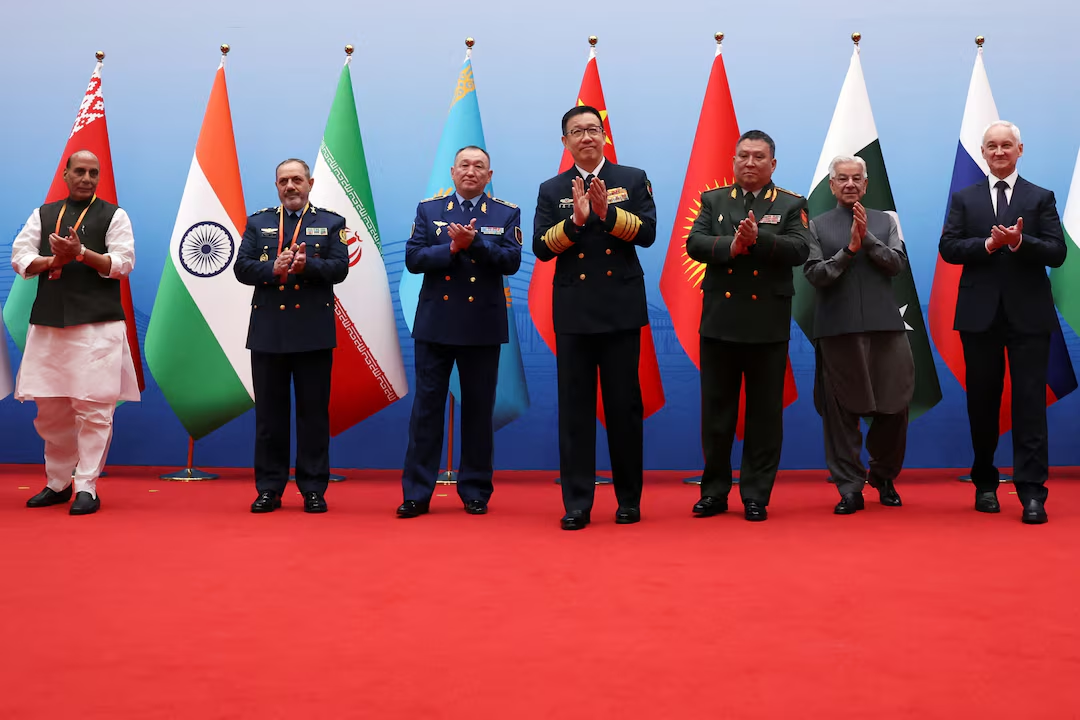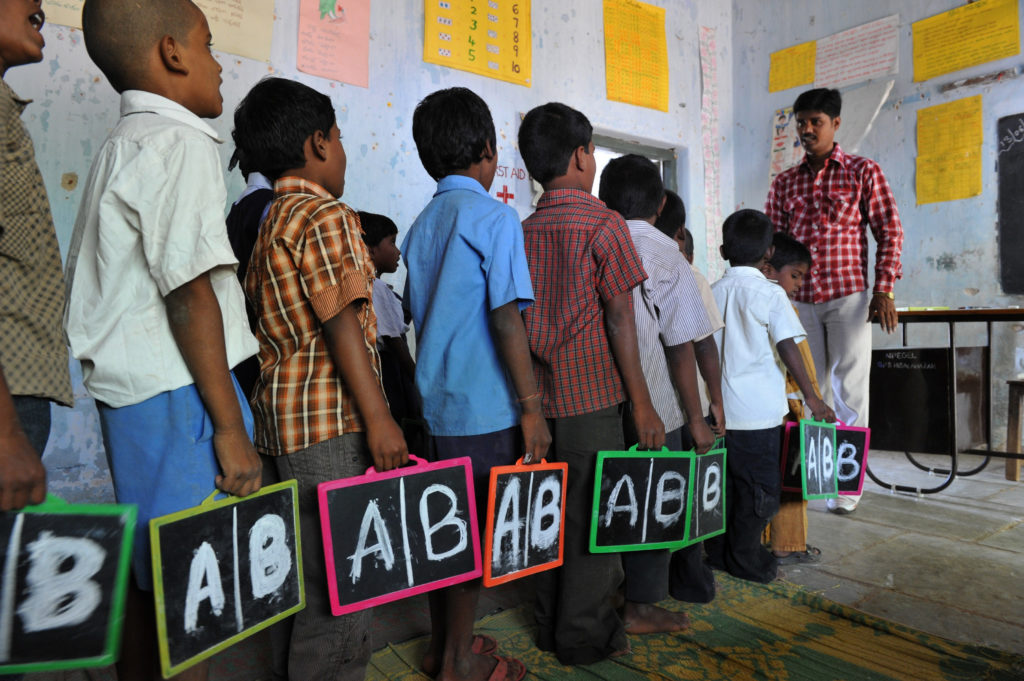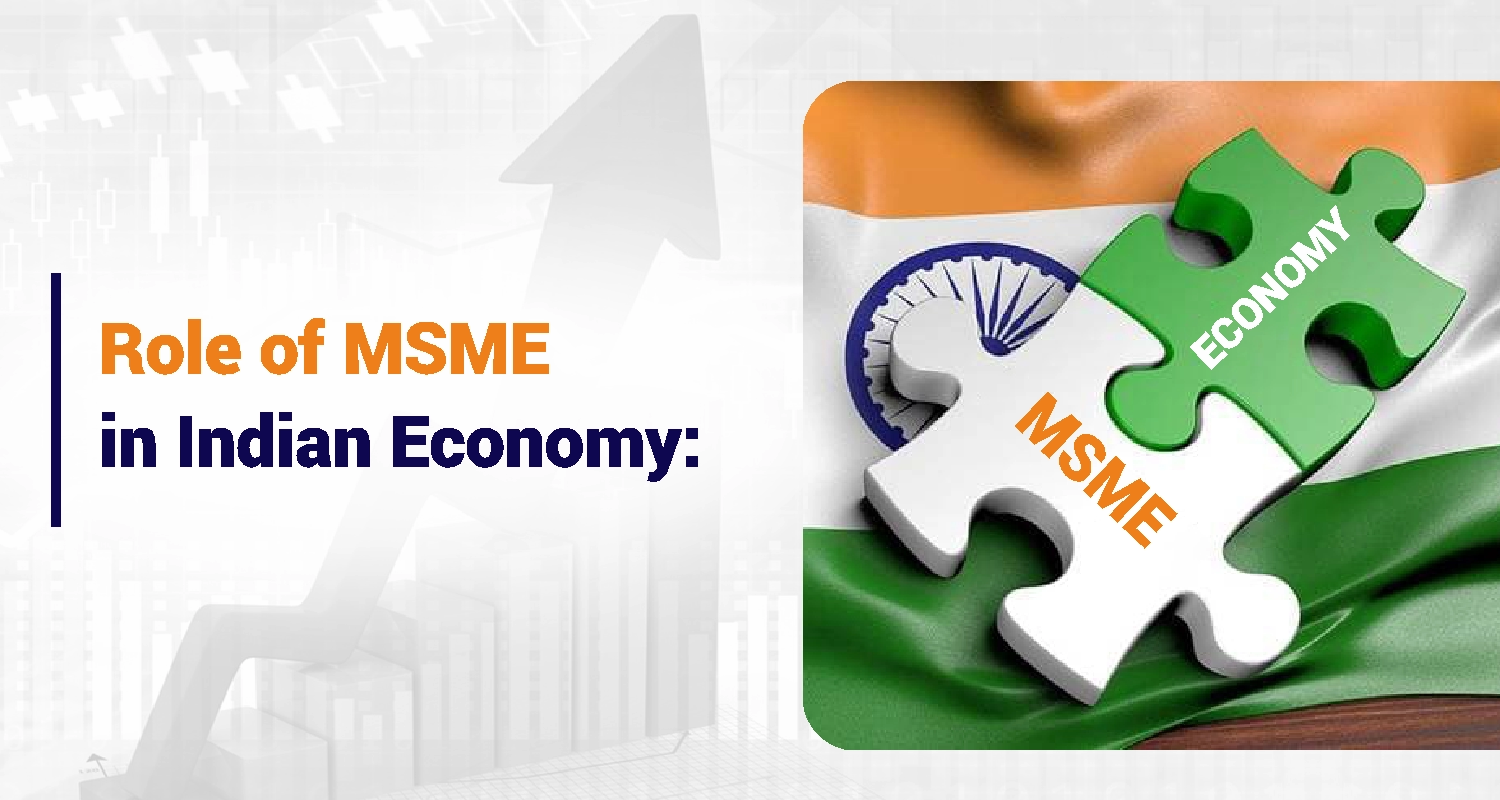- Courses
- GS Full Course 1 Year
- GS Full Course 2 Year
- GS Full Course 3 Year
- GS Full Course Till Selection
- Answer Alpha: Mains 2025 Mentorship
- MEP (Mains Enrichment Programme) Data, Facts
- Essay Target – 150+ Marks
- Online Program
- GS Recorded Course
- Polity
- Geography
- Economy
- Ancient, Medieval and Art & Culture AMAC
- Modern India, Post Independence & World History
- Environment
- Governance
- Science & Technology
- International Relations and Internal Security
- Disaster Management
- Ethics
- NCERT Current Affairs
- Indian Society and Social Issue
- NCERT- Science and Technology
- NCERT - Geography
- NCERT - Ancient History
- NCERT- World History
- NCERT Modern History
- CSAT
- 5 LAYERED ARJUNA Mentorship
- Public Administration Optional
- ABOUT US
- OUR TOPPERS
- TEST SERIES
- FREE STUDY MATERIAL
- VIDEOS
- CONTACT US
RECOGNITION OF SAME-SEX MARRIAGE IN INDIA STILL FAR FROM REALITY
RECOGNITION OF SAME-SEX MARRIAGE IN INDIA STILL FAR FROM REALITY
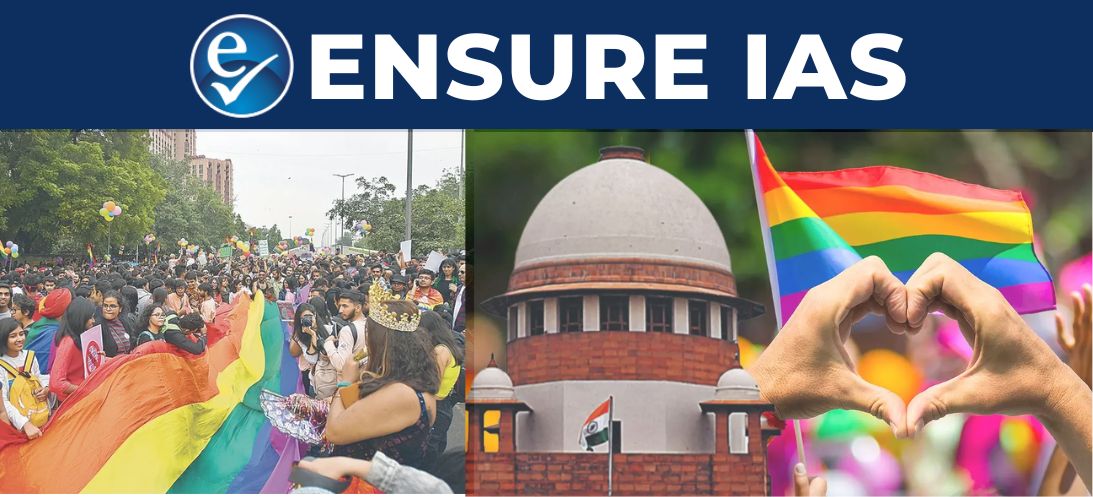
- Recently, in January 2025, the Supreme Court dismissed petitions seeking review of its October 17, 2023, ruling that had rejected the prayer to grant legal recognition to same-sex marriages.
- A five-judge bench found no error apparent on the face of the record of the majority view authored by Justice (retired) S Ravindra Bhat in the 2023 ruling.
- This decision highlights the ongoing resistance to the recognition of same-sex marriages within the Indian legal framework. Despite growing advocacy and the progressive steps taken in other areas of LGBTQ+ rights, marriage equality in India remains a highly contentious issue.
What is same sex marriage?
- Same-sex marriage refers to the legal union between two individuals of the same gender. It is an aspect of homosexuality which refers to having sexual interest in and attraction to members of one’s own sex or gender.
- The term gay is frequently used as a synonym for homosexual; female homosexuality is often referred to as lesbianism.
- Same-sex marriage has become a central focus of the LGBTQ movement agenda since the early 2000s, with the aim of achieving equal marriage rights for all individuals regardless of sexual orientation.
- The LGBTQ movement is a social movement that advocates for the rights of lesbian, gay, bisexual, transgender, and queer people. The movement's goal is to achieve social equality and respect for all people, regardless of their sexual orientation, gender identity, or sex characteristics.
What is the status of same-sex marriage in India?
The Indian legal system does not recognize same-sex marriages, and the country’s laws define marriage as a union between a man and a woman. However, there have been certain significant developments:
- The Supreme Court of India in August 2022 provided social security rights to those in same-sex live-in relationships while also recognising same-sex couples as being part of a "family unit".
- Since the 2010s, courts in several states, including Gujarat, Himachal Pradesh, Kerala, Odisha, Punjab, Uttar Pradesh, and Uttarakhand, have ruled on an individual basis that live-in relationships between same-sex couples are not unlawful and entitled to legal protection. This has often only entailed limited inheritance benefits or police protection from family
- On 1 April 2022, MP Supriya Sule from the Nationalist Congress Party introduced a bill to the Lok Sabha to legalise same-sex marriage under the Special Marriage Act. The proposal would amend various sections of the Act to provide same-sex couples with the same legal rights as opposite-sex couples. The bill would fix the marriageable age at 21 for gay couples and at 18 for lesbian couples. No action was taken on the bill.
How has the Supreme Court responded on Same-sex Marriage?
- In October 2023, a five-judge Constitution bench of the Supreme Court on Tuesday refused to grant legal recognition to same-sex marriages.
- It refused to tweak the Special Marriage Act to recognise same sex marriages saying there was “no unqualified right” to marriage, and a same-sex couple could not claim it as a fundamental right under the Constitution.
- The Special Marriage Act, 1954 is an Act of the Parliament of India with provision for civil marriage for people of India and all Indian nationals in foreign countries, irrespective of religion or faith followed by either party.
- The bench had left it to Parliament to change the law to validate such a union.
-
Minority view in the 2023 ruling
- Former CJI D.Y Chandrachud and Justice (since retired) Kaul spoke in favour of a civil union, but it ended up being the minority view. Former CJI Chandrachud said that this right to civil union or right to enter an abiding cohabitational relationship could be traced to Part III of the Constitution. It has also been laid down in various judgments of the court – Navtej Johar, K S Puttaswamy, NALSA, Shakti Vahini, Shafin Jahan etc. Thus, the State had a positive obligation to accord recognition to it.
- Civil union is a legally recognized arrangement similar to marriage, created primarily as a means to provide recognition in law for same-sex couples.
- Former CJI D.Y Chandrachud and Justice (since retired) Kaul spoke in favour of a civil union, but it ended up being the minority view. Former CJI Chandrachud said that this right to civil union or right to enter an abiding cohabitational relationship could be traced to Part III of the Constitution. It has also been laid down in various judgments of the court – Navtej Johar, K S Puttaswamy, NALSA, Shakti Vahini, Shafin Jahan etc. Thus, the State had a positive obligation to accord recognition to it.
What are arguments for the recognition of Same-sex marriages?
- Basic Human right: The Human Rights Charter says that the right to get married is part of the right to start a family. As per advocates of marriage equality, it is applicable to everyone no matter what gender they are.
- Implied fundamental right: It has been claimed that right to marriage for non-heterosexual couples is implied in Articles 14, 15, 16, 19, and 21. This is especially after the SC rulings in ‘Navtej Singh Johar vs. Union of India’ (2018) (decriminalization of homosexuality) and ‘KS Puttaswamy and Anr. vs. Union of India’ (2017) (upheld the fundamental right to privacy).
- Issue of inequality: According to same-sex couples and LGBTQ activists the government’s refusal to acknowledge same-sex marriage is a violation of the Constitutional right to equality and the privileges that married heterosexual couples enjoy.
- LGBTQ+ people are denied the rights that come with a legal marriage, such as the right to adopt, receive, and be taken care of.
- Personal satisfaction and self-confidence: Same-sex couples believe that tying the knot will give their relationship significance, direction, and a distinct sense of self.
- Delhi Commission for Protection of Child Rights: Same-sex couples would be just as good parents as straight parents to children raised by them. By making gay marriages illegal, the state is denying the child the legal protection of having two parents and a guardian.
What course of action for recognition of same-sex marriages has been proposed?
- SC’s recognition of same-sex marriage: This will eventually lead to a situation where society accepts it.
- Rewording of Special Marriage Act, 1954: It should be reworded to read marriage as between spouses instead of “man and woman”.
- Other administrative modifications, modifying subordinate legislation such as rules and regulations.
What are the arguments against Same-sex marriage?
-
Centre’ s arguments:
- Against Indian ethos: The Centre’s fundamental argument is that same-sex marriage is not recognised in Indian traditions, ethos and culture.
- Impact on the institution of marriage: Marriage is considered as a sacrament between a biological male and a biological female to make a holy union in order to have children. Same-sex marriage could negatively impact such societal conceptions of the institution of marriage.
- Jurisdiction of the Parliament: Parliament, rather than the Court is the appropriate institution to consider the legalization of same-sex marriages. This is because marriage is a crucial component of a nation’s social policy. Thus, the recognition of same-sex marriage is the responsibility of the elected representatives of the people.
- Representation of urban elitist attitudes: It is believed that the demand represented urban elitist attitudes and would not be supported by the majority of people.
- Misuse in the future: In the future arguments about sexual orientation freedom and autonomy could be used to challenge the law on incest which is prohibited.
- Not a matter of right: According to the Centre, creation or recognition of a new social institution cannot be claimed as a matter of right or choice, much less a fundamental right.
- National Commission for Protection of Child Rights: It stated that same-sex marriage would violate the terms of the Juvenile Justice Act. The Juvenile Justice Act of 2015 makes it illegal for a single male, let alone two men, to adopt a girl child.
- Religious organisations: Several minority religious organisations in India have opposed the legalisation of same-sex marriages as being “against religion” and “unnatural”.
- Response of states: States such as Rajasthan, Assam, and Andhra Pradesh opposed the plea seeking legal recognition for same-sex marriages.
What is the status of same-sex marriage in the world?
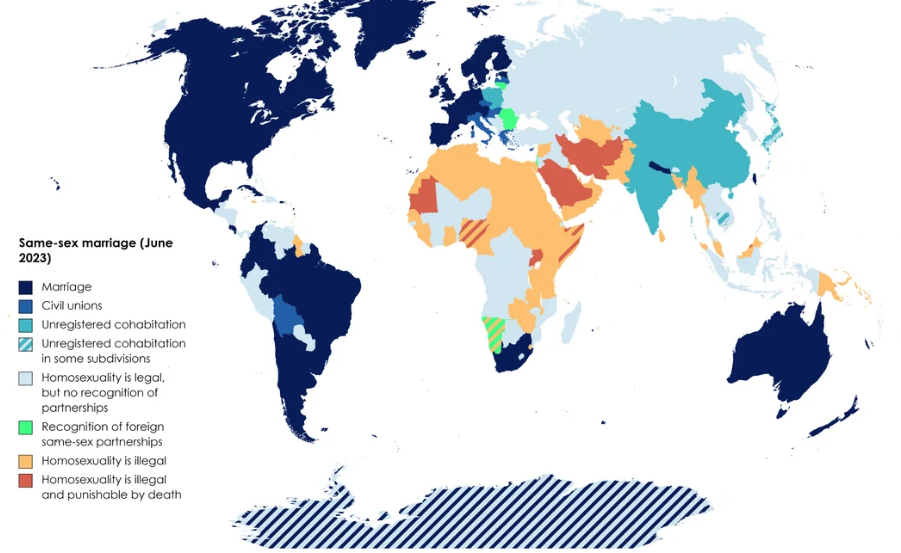
- In 1989, Denmark became the first country to legally recognize a relationship for same-sex couples, establishing registered partnerships, which gave those in same-sex relationships "most rights of married heterosexuals, but not the right to adopt or obtain joint custody of a child".
- Eventually, in 2001, the Netherlands became the first country to broaden marriage laws to include same-sex couples.
- Till date, same-sex marriage has been established by law in 34 other countries, including most of the Americas and Western Europe. Yet its spread has been uneven — South Africa is the only country in Africa to take the step; Taiwan, Nepal and Thailand are the only ones in Asia.
- On 12 March 2015, the European Parliament passed a non-binding resolution encouraging EU institutions and member states to "reflect on the recognition of same-sex marriage or same-sex civil union as a political, social and human and civil rights issue".
- Recently, in January 2025 Thailand legalized same-sex marriage.
A further glimpse into the LGBTQ movement
What are the objectives of the movement?
- Legal Equality: Such as decriminalization of Same-Sex Relationships, marriage equality and anti-discrimination laws.
- Social Acceptance: Through eradication of stigma, education and awareness.
- Protection of rights: Such as protection against harassment and violence, freedom of expression etc.
- Recognition of Gender Diversity: Ensuring the right to self-identify and legal recognition of non-binary and transgender identities.
What is the LGBTQIA+ community?
- The community encompasses people who are lesbian, gay, bisexual, transgender, queer, intersex, and asexual. The "+" in the acronym represents other identities that are not included in the letters. As society’s understanding, recognition, and inclusion of diverse sexual identities and gender expressions has grown, so has its acronym.
- Lesbian - A woman who is romantically, emotionally, or sexually attracted to other women.
- Gay - A person (usually a man) who is romantically, emotionally, or sexually attracted to people of the same gender.
- Bisexual - A person who is romantically, emotionally, or sexually attracted to more than one gender
- Transgender - A person whose gender identity does not align with the sex assigned to them at birth.
- Queer - An umbrella term for individuals who do not conform to societal norms regarding gender identity and sexual orientation.
- Intersex - A person born with physical sex characteristics (e.g., chromosomes, hormones, or genitalia) that do not fit typical definitions of male or female bodies.
- Asexual - A person who experiences little or no sexual attraction to others.
2. The LGBTQ Movement also has observances like the LGBT History month and symbols like the Rainbow flag which was invented by Gilbert Baker. Each colour on the flag represents a value in the community:
- Pink = sexuality
- Red = life
- Orange = healing
- Yellow = the sun
- Green = nature
- Blue = art
- Indigo = harmony
- Violet = spirit
What was the development of LGBTQ movement in India?
-
In Ancient and Medieval India
- LGBTQ people are well documented in various artworks and literary works of Ancient India, with evidence that homosexuality and trans-sexuality were accepted by the major dharmic religions.
- The Second Part, Ninth Chapter of Kama Sutra specifically describes two kinds of men that we would recognize today as masculine-type and feminine-type homosexuals
- Many erotic artworks depicting homosexuality can be found on numerous temples throughout India, including Khajuraho temple sculptures and the Sun temple in Konark.
- In Modern India: There have been several key events in India that have shaped the country’s approach to LGBTQ+ rights over the years. They are:
- Founding of LGBTQ+ organizations: In the 1990s, the first LGBTQ+ organization, the AIDS Bhedbhav Virodhi Andolan (ABVA), was founded in Delhi to fight against discrimination and violence faced by the LGBTQ+ community.
- Naz Foundation’s PIL: In 2001, the Naz Foundation, a non-governmental organization, filed a public interest litigation (PIL) in the Delhi High Court challenging the constitutionality of Section 377.
- Section 377 of the Indian Penal Code, 1860 introduced by the British colonial government said, “whoever voluntarily has carnal intercourse against the order of nature with any man, woman or animal, shall be punished with imprisonment for life, or with imprisonment of either description for a term which may extend to 10 years, and shall also be liable to fine.”
- It led to the criminalization of homosexuality/same-sex relationships.
- Naz Foundation v. Govt. of NCT of Delhi (2009): The Delhi High Court declared Section 377 unconstitutional and decriminalized homosexuality. However, the Supreme Court in 2013 overturned the Delhi High Court’s judgment and reinstated Section 377.
- National Legal Services Authority (NALSA) vs. Union of India & Others (2014): The court recognized transgender individuals as a distinct third gender. Also, transgender individuals are entitled to fundamental rights guaranteed under the Indian Constitution.
- Navtej Singh Johar & Ors. v. Union of India (2018): The Supreme Court of India partially struck down Section 377 of the Indian Penal Code, decriminalising same-sex relations between consenting adults.
- The Court, however, upheld provisions in Section 377 that criminalise non-consensual acts or sexual acts performed on animals.
- It found that Section 377 discriminates against individuals on the basis of their sexual orientation and/or gender identity, violating Articles 14 and 15 of the Constitution. Further, they ruled that Section 377 violates the rights to life, dignity and autonomy of personal choice under Article 21. Finally, they found that it inhibits an LGBT individual’s ability to fully realize their identity, by violating the right to freedom of expression under Article 19(1)(a).
Trump’s executive order on gender
- On his very first day in office, US President Donald Trump issued a slew of executive orders which rolled back protections to LGBTQIA+ persons extended by the Biden administration
- According to the order, “it is the policy of the United States to recognize two sexes, male and female”, and that the term “gender identity” is “disconnected from biological reality and sex”.
Sex vs Gender
|
Aspect |
Sex |
Gender |
|
Definition |
Biological characteristics that define male and female bodies. |
Social and cultural roles, behaviours, and identities that societies consider appropriate for men and women. |
|
Attributes |
Chromosomes, hormones, genitalia. |
Expectations, roles, norms, and behaviours. |
|
Determination |
Assigned at birth based on physical anatomy. |
Can be self-identified and may differ from the sex assigned at birth. |
|
Categories |
Male, Female, Intersex. |
Man, Woman, Non-binary, Genderqueer, etc. |
|
Fluidity |
Generally considered fixed and binary (although intersex variations exist). |
Can be fluid and encompass a spectrum of identities. |
|
Influence |
Biological and physical factors. |
Social, cultural, and individual factors. |
- This distinction between sex and gender plays a significant role in the foundation of the LGBTQ movement, as gender identity (how one identifies) may not align with sex assigned at birth. Also, sexual orientation (who one is attracted to) is independent of both sex and gender.
3. What are the expected implications of the order in the US?
- Protection of women’s rights: By preventing men to self-identify as women and gain access to intimate spaces like washrooms and activities designed for women such as sports events.
- Cut in federal funding, for schools that were “pushing radical gender ideology”.
- Government-issued identification documents including passports and visas will only reflect the sex a person is assigned at birth, and not their gender identity.
- Changes to Federal medical insurance coverage, which could no longer include costs for gender-affirming care, including hormone therapy and gender affirming surgeries.
Conclusion
With reference to the LGBTQ movement in India, the journey towards recognition of same-sex marriages is complex in a country as diverse as India, where societal values are deeply rooted in tradition and religion. There is a need to balance progressive legal reforms with efforts to build societal acceptance to avoid conflicts and foster an inclusive environment. This requires education, awareness, and dialogue to challenge stereotypes and build understanding. This can ensure that the principles of equality and inclusivity enshrined in the Constitution are realized, while respecting India's cultural diversity and collective ethos.
|
Also Read |
|
FREE NIOS Books |
UPSC Daily Current Affairs |
UPSC Monthly Mgazine |
Previous Year Interview Questions |
Free MCQs for UPSC Prelims |
UPSC Test Series |
ENSURE IAS NOTES |
Our Booklist |


